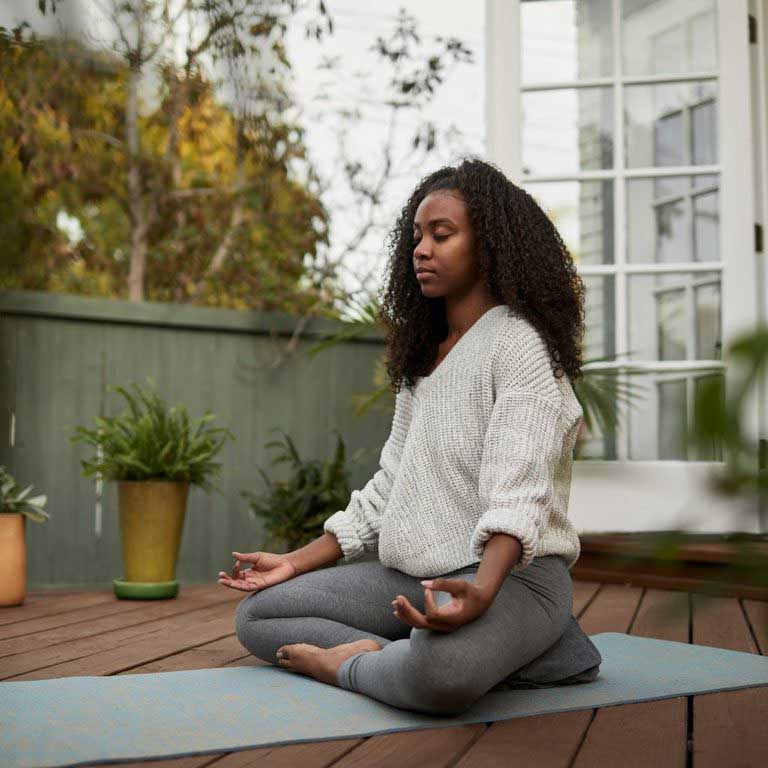Being healthy is more than just being fit and physically capable of doing some extreme action. You can say that complete health and beauty also come from the mind or mind. This is why many lifestyle practitioners advise people to do meditation. But what is it? Before doing and trying it, learn more from the following definition of meditation and other details.
What Is the Definition of Meditation?
Meditation has a stereotypical point of view, in which people see it as a way to be a different person, a better person, or a new person. That is a complete cap or wrong mindset about the action. It goes beyond that since meditation is an ancient practice that has mental benefits for people to expect. At the same time, it adapts to modern technology.
So, what exactly is it? If you consider the complex benefit and the biggest practice point of meditation, you will see it as a practice involving focusing and clearing your mind using both mental and physical techniques. It is also about awareness training, helping you to get a sense of perspective. Thus, it brings out the complex health action possible.
The said definition indicates that meditation is rather complex compared to how people see it. It is not about learning to observe your feelings, turning them off, and getting better. The practice of meditation brings various benefits, based on the type you are going to do. It is good to reduce stress and anxiety, relax, improve your health, or adapt to a certain challenge.
Generally, you can see people meditating as people that seem to do nothing or anything other than breathing and repeating sounds or phrases. This situation helps gather and people focus, helping and creating a positive effect on your brain and mental health. With that, the best definition should be a mental and physical technique practice for good benefits.
How Do You Meditate? Follow These 10 Simple Steps for Beginners
To give more perspective on meditation, consider how it works and how you do it. One sure thing is that there is no perfect or correct way to meditate. It takes many different forms, focuses, or practices, which make it pretty vast and different to explore. Some of the ways include the following details.
1. Contemplation
Contemplation meditation usually involves various concentrations of questions or contradictions inside the mind. People use this kind of meditation to secure and keep their minds on the problem, letting them try to find a solution without letting their minds wander. It is a good meditation that can help people improve their mental activity.
2. Body-Center Meditation
Body center can also lead or known as self-scanning meditation. People do this as being quiet and meditating help them focus on the physical sensations. It helps their mind and body balance and helps them feel better throughout their body. Sometimes it practices scanning the body to find anything like pain or tension, anything that is out of the ordinary.
3. Mantra
The common word repetition or saying the phrase over and over again is what you can find in mantra meditation. This reputation can be done either aloud or in your head. Sometimes, the mantra or the words are meant to put a mindset to do something. It can be an encouraging practice, as the person tries to stay true to their word.
4. Movement
The common meditation people do is focusing on breathing, performing specific body movements, or holding their breath. This kind of practice is part of movement meditation, which can also involve many other actions. It is good to keep your mind and body working properly as meditation puts your mind in a clear or focused situation.
5. Mindfulness
Among other types of definitions of meditation, the mindfulness type is what many people do and understand. It refers to the form of meditating while staying aware of what is happening at the moment. It helps people to keep their mind intake, not letting their mind wander, worrying about the past or future.
6. Emotion Centered
Focusing on a certain emotion is the benefit or the focus of emotion-centered meditation. As the name says, it keeps the person to stay focused on a specific emotion, such as being happy and kind to others. The idea is pretty grounding as the emotion helps keep the mind healthy.
7. Visual Based
Visual-based meditation focuses on the practice where the meditation uses or focuses on something you can see. Sometimes it uses mental images or visuals you can see with your eyes. As you concentrate on the image, it can prevent your mind from wandering or going beyond. It is also a nice way to preserve the memory of a person.
Is Meditation Related to Religious Belief or Routine?

As you can see how the meditation form can propose various functions and benefits. It highlights or tells that the definition of meditation can also go beyond what you consider it to be. It is also great to underline that there are chances for meditation as part of religious practice. But it does not mean you should be religious to meditate. Here are some examples.
1. Meditation in Christian
There is a meditation that is introduced in Christianity. It is contemplation, which helps the person to focus intently on the religious, idea, or question concept or deity. It is a pretty common practice in the religion, as meditation works as a way to reflect on their life. Praying can also be classified as meditation.
2. Meditation in Buddhist
Buddhist meditation appears in different forms, which show possible origin in the religion. Some of the differences pinpoint the nation of origin and the teaching since it may have distinct philosophies or religious practices. Some examples of Buddhist meditations are Zen from China or Japan, Tantric from Tibet, and Theravadan in southeast Asia (mostly in India and Thailand).
3. Meditation in Taoist
Similar to Buddhism, meditation is a common religious practice in Taoism. It is considered a religion and philosophy as meditation originated in China. There are also pretty neat details on how the Taoist meditation was found in the founder’s writing, Laozi. From there, the definition of meditation gets even bigger and transcendent in a non-religious form.
4. Nonreligious Forms of Meditations
The best example of nonreligious forms of meditation is yoga, where the physical form of meditation and exercise originated in India. Some other forms can include Transcendental involving mantras and phrases, guided meditation for therapy or counseling, and Osho which focuses on breathing exercises. It explains the wide range of meditations and their forms.
What Are the Benefits of Meditation? These You can Get
Considering the various forms and origins of meditation, you can expect different kinds of benefits from its practices. It is also best to keep in mind that meditation is not a form of medication, but a complementary practice that helps take care of the physic and mind. It is mostly related or commonly linked to inner peace and mental health.
If you put it in a bigger sense of possible benefits, there are some aspects to pinpoint. Meditation is the way to keep your senses calm, balanced, and calm. It can benefit both emotional and physical health, even overall health. Some forms also help cope and relax from stress to learn inner peace. Since it has a huge scope, at least you can learn from the following details.
1. Meditation and Emotional and Physical Well-Being
Among many benefits, the relation of meditation with emotional or mental health is the main purpose of the practice. In general, when people meditate it turns into a way to clear away information overload that contributes to stress. As meditation composes light physical activities, it also gives benefits to physical well-being.
If you want to highlight any possible benefits from the said or given definition of meditation, there are several details. The one and foremost is gaining a new perspective on stressful situations. It also increases self-awareness as the practice focuses on mindfulness. In many other situations or uses, meditation works in increasing patience, tolerance, imagination, and creativity.
Some other benefits should be mental health and mind cleansing, as the practice manages your stress. Some events reduce negative emotions and focus on the present. As the mind heals, the relaxing body also gets benefits. Meditation is known to help lower resting heart rate and blood pressure plus improve sleep quality.
2. Meditation and Illness
Something that is beyond the mind and physical condition is the relationship between meditation and illness. There are several cases and research that support the health benefits of meditation, including the possibility of taking care of illnesses. But it is best to understand that the profits are likely useful for medical conditions worsened by stress.
Some of the conditions and illnesses that can be improved with the help of meditation include asthma, cancer, anxiety, chronic pain, depression, and several mental-related condition. Some illnesses with stress-related situations, such as heart disease, sleep problems, high blood pressure, and tension headaches can also get better.
One thing is for sure, not all illnesses can be fixed or immediately get better with meditation. The practice is mainly focused on an alternative or additional medication. In other words, meditation might worsen some symptoms associated with certain mental health illnesses. Thus, it is best to mention that meditation is not a replacement for traditional medical treatment.
How to Start A Meditation Routine? 5 Things You Should Prepare Before Meditation
If you are interested in trying the meditation routine, you don’t have to do much or worry about the process. As said in the definition of meditation, there is no perfect practice. But it does need proper ways to make and get the best benefits of meditation. Here are several ways and tips to start your meditation.
1. Talk to Your Healthcare Provider
Before you got into meditation, be sure you got some approval from a healthcare provider. The primary care provider and mental health provider might give you some information about the routine, the do’s and don’ts. Some might even lead you to a professional or instructor in your area.
2. Do Some Research
Don’t forget to do some research about what you are going to do. Meditation is vast and different in many ways. Some types or forms might be better for you to take than others. It is a good step to learn what you can do and get from meditation. Currently, there is much information about meditation that can help you get a proper routine to start a healthy body and mind.
3. Get or Ask for Guidance
Even though there is no perfect or allegedly truer meditation, it is good to get some guidance or an instructor. You might find some people that have similar interests in what you want to do. Sharing information and meditation practice is one of the ways to get into meditation. You can use online details, as some popular yoga or meditation classes are open for free.
4. Propose the Time to Do Your Preferred Routine
If you find what you want to do or learn, start getting yourself time and commitment. Most people who are getting into meditation are trying to spare some time to relax. So, you have to start making time in your day for meditation. It does not need hours to do, the key is to make it a routine and commit to the practice. Believe in the process for the best result.
5. Set the Surrounding
To make the meditation work better, get yourself in the best place or surroundings. The best place to do the routine is a quiet, comfortable, and calming place. The practice can also involve sitting, lying down, or walking. Pick whatever fits your routine. You can do it at home, park, or walking trail. Remember that the definition of meditation highlights well-balanced health, both mind and physical. So, do it right!
As you can see from the information, meditation is more than just being quiet and silent. It is something related to your mindfulness activity, relaxation, and mental behavior. There is nothing like a perfect meditation, but everyone can start and do it as a routine. It fully embraces the idea of a healthy inside.
- Tirzepatide and Hair Loss: Side Effects Explored - July 2, 2025
- Unlock the Mystery: Are Your Headaches a Sign of Hypertension? - June 24, 2025
- Boost Your Heart: Omega-3 and Blood Pressure Secrets - June 14, 2025






